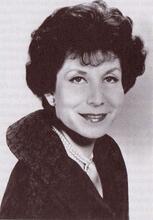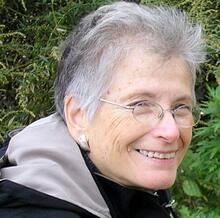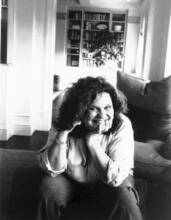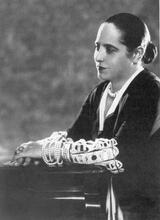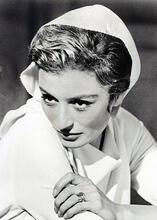Rama Burshtein
Photo of writer/director Rama Burshtein in 2009 by Ehud Arieli, via Wikimedia Commons.
Rama Burshtein’s films are among the most important created by a Haredi woman. Born in the United States, Burshtein grew up in Israel and turned to religion when she was in her mid-20s. Her first commercial film was shown exclusively to Haredi women. Burshtein found the conventions of Haredi cinema poorly suited to her artistic aspirations, however, and her later films were aimed at the nonreligious world. As a Haredi woman filmmaker, she sheds light on a world previously considered benighted, transforming Haredi constraints into a source of strength and teaching her nonreligious viewers about the humanity of Haredim. Making films for a mainstream Israeli audience, she portrays romance and relationships between men and women, unlike films intended only for an ultra-Orthodox female audience.
Family and Jewish Identity
Rama Burshtein, née Brimmer, was born in 1967 in the United States, to Jacob Dreamer, a sailor, and Phyllis Dreamer, a jazz singer and actress. When she was a year old, her parents immigrated to Israel, and she grew up and was educated in Kfar Saba. In 1985, she returned to the United States, where she lived until 1989. In 1990, she began studying in the Sam Spiegel of Film and Television School in Jerusalem. The Dreamer family was nonreligious, and Burshtein turned to religion in the early 1990s, when she was in her mid-20s.
Burshtein is married to Liron Burshtein, who also took up religion as an adult; they have four children. The family belonged to Rabbi Mordechai Auerbach’s Congregation Abir Yaakov in Tel Aviv and drew inspiration from the Breslov Hasidic movement. Burshtein later divorced her husband and remarried in 2020; she is now known as Rama Burshtein-Shai.
Pioneering Haredi Women Filmmaker
Rama Burshtein’s films are among the most important created by a An ultra-Orthodox JewHaredi (“ultra-Orthodox”) woman.
Her first commercial film, How Much Does Hope Cost? (2004), was produced as a Haredi work and shown exclusively to Haredi women. However, Burshtein found the conventions of Haredi cinema poorly suited to her artistic aspirations and turned to a different audience. Her two later works, Fill the Void (2014) and The Wedding Plan (2017), were aimed at the nonreligious world and produced as Israeli films with funding from Israeli film foundations.
As a woman with a Haredi outlook who creates Israeli cinema, Burshtein sheds light on a world previously considered benighted, transforming Haredi constraints into a source of strength. She teaches her nonreligious viewers that Haredim are, after all, people with weaknesses and cravings. While making this point, however, she maintains her distance from her heroes’ identities, their surroundings, and their observant lives.
Burshtein’s films portray a milieu that includes romantic if not erotic terms. Unlike ultra-Orthodox women's films intended only for an ultra-Orthodox female audience, Burstein, making films for a mainstream Israeli audience, portrays romance and relationships between men and women. Being ultra-Orthodox herself, however, she does not present the viewer with explicit sexuality; although eroticism is not shown explicitly, it is implied.
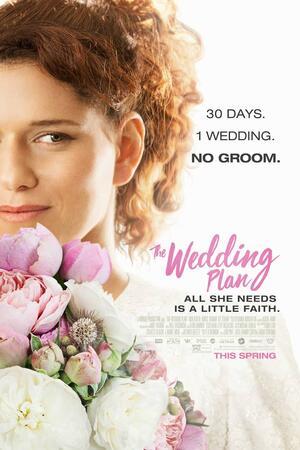
Movie poster for The Wedding Plan (2017) directed by Rama Burshtein.
In Fill the Void, Burshtein takes up a human dilemma that manifests in ways both small and large that typify the Haredi world and the Haredi family. Shira Mandelman (Hadas Yaron) is about to be introduced to an eligible young man for marriage, but when her sister Esther dies in childbirth, leaving behind a young widower and a baby, her mother (Irit Sheleg) manipulates the situation so that Shira will stand in for her sister. In the comic The Wedding Plan, a newly Orthodox woman, left stranded when her fiancé cancels the wedding, decides to embark on a quest for the hoped-for groom and to proceed with the wedding regardless. Burshtein’s films promote diversity and open a new and important view into the Haredi world.
Representation of Haredim in Cinema
Representations of Haredim in fictional cinema have been found mainly in canonic vehicles such as The Jazz Singer (Crosland, 1927) and Fiddler on the Roof (Jewison, 1971), and more recent films such as The Chosen (Kagan, 1981), A Price Above Rubies (Yachin, 1998), Kadosh (Gitai, 1999), and Bruria (Kushnir, 2008), all of which criticize the Haredi Other. These works have largely given way to films that promote empathy and an awareness that behind the attire and the ritual lie characters with whom everyone can identify; examples include Holy Rollers (Asch, 2001), Mendy: A Question of Faith (Vardi, 2003), and Felix and Meira (Giroux, 2014). Burshtein’s Fill the Void and The Wedding Plan, shown at more than 150 film festivals around the world, further these new representations of Haredim on the screen, promoting a new depiction of the Haredi world and changing the image of the Haredi woman.
Burshtein, who also directed the Haredi film How Much Does Hope Cost?, speaks about nuances and minutiae in Haredi women’s cinema that she found hard to accept as someone new to religious observance: “Haredi art-making is subordinate to the status of Haredi society. For that reason, we took How Much Does Hope Cost? to an important Haredi woman educator and asked her to give the film her endorsement. There was a little scene with two women Holocaust survivors talking, one saying to the other, ‘It sounds like chewing gum.....’ So the educator wrote to us to delete the words ‘chewing gum’ because it’s street talk. For me, these codes are far from Hashem [God]; they’re off-putting and segregational.” Haredi cinema, Burshtein argues, should be considered a leisure culture and not an art form because it lacks audacity and has a sectarian constraint: “It’s the beginning of a leisure culture, but even if the codes evolve, some will never be cracked because, then, what would become of the children’s matchmaking prospects?” (Vinig, interview with Burshtein).
Over the past few decades, Haredi cinema has been buffeted by many changes, including the relationship between Haredi women’s cinema and mainstream Israeli cinema, as reflected in films that straddle the line between them. Examples of such works are those of the lapsed-Orthodox filmmaker David Wolf (Summer Vacation, 2007) and Burshtein’s own work. The Haredi audience’s relationship with films by Israeli Haredi artists, and the acceptance of Haredi women’s cinema worldwide, are new trends, even though films such as Ushpizin (Dar, 2004), Burshtein’s Fill the Void (2014) and The Wedding Plan (2017), and Unorthodox (Malka, 2018) were facilitated by Israeli film foundations and express new paths to acceptance for Haredi characters, who until two decades ago were termed “the Other” in Israeli cinema. The growing acceptance of cinema as a genre that reflects the authentic Haredi world is also facilitated by films by Haredi artists outside Israel, such as 93Queen (Paula Eiselt, 2018) and Menashe (Weinstein and Lustig, 2017).
Vinig, Marlyn. Haredi Cinema. Tel Aviv: Resling, 2011. [Hebrew]





